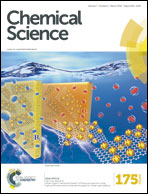Dehydrocoupling of phosphine–boranes using the [RhCp*Me(PMe3)(CH2Cl2)][BArF4] precatalyst: stoichiometric and catalytic studies†
Abstract
We report a detailed, combined experimental and computational study on the fundamental B–H and P–H bond activation steps involved in the dehydrocoupling/dehydropolymerization of primary and secondary phosphine–boranes, H3B·PPhR′H (R = Ph, H), using [RhCp*(PMe3)Me(ClCH2Cl)][BArF4], to either form polyphosphino-boranes [H2B·PPhH]n (Mn ∼ 15 000 g mol−1, PDI = 2.2) or the linear diboraphosphine H3B·PPh2BH2·PPh2H. A likely polymer-growth pathway of reversible chain transfer step-growth is suggested for H3B·PPhH2. Using secondary phosphine–boranes as model substrates a combined synthesis, structural (X-ray crystallography), labelling and computational approach reveals: initial bond activation pathways (B–H activation precedes P–H activation); key intermediates (phosphido-boranes, α-B-agostic base-stabilized boryls); and a catalytic route to the primary diboraphosphine (H3B·PPhHBH2·PPhH2). It is also shown that by changing the substituent at phosphorus (Ph or Cy versustBu) different final products result (phosphido-borane or base stabilized phosphino-borane respectively). These studies provide detailed insight into the pathways that are operating during dehydropolymerization.
![Graphical abstract: Dehydrocoupling of phosphine–boranes using the [RhCp*Me(PMe3)(CH2Cl2)][BArF4] precatalyst: stoichiometric and catalytic studies](/en/Image/Get?imageInfo.ImageType=GA&imageInfo.ImageIdentifier.ManuscriptID=C5SC04150C&imageInfo.ImageIdentifier.Year=2016)

 Please wait while we load your content...
Please wait while we load your content...